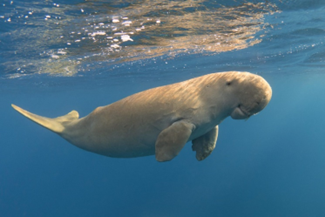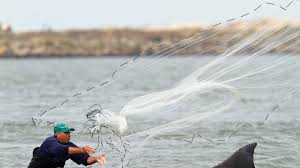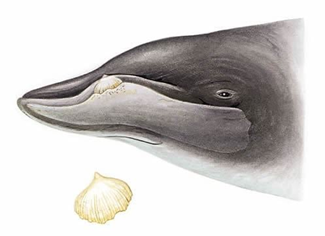Geography, Mapping, Ecology & Environment
Dugongs:
-
- Status & Protection: Vulnerable (IUCN); Schedule I under Wildlife Protection Act.
- Distribution in India: Gulf of Mannar–Palk Bay, Andaman & Nicobar Islands, Gulf of Kutch.
- Population: Estimated <250–450 individuals; region-wise numbers are very low.
- Ecological Role: Graze on seagrass; maintain seagrass health, support blue carbon storage, enhance marine productivity.
- Major Threats:
- Accidental capture in fishing nets (bycatch)
- Pollution (heavy metals)
- Seagrass habitat loss due to coastal activities
- Very slow reproduction
- Conservation Steps:
- Task Force for Dugong Conservation; National Recovery Programme
- Dugong Conservation Reserve (Palk Bay, Tamil Nadu, 448 sq km)
- Focus on reducing fishing-related mortality.

(IE)
Dolphin-assisted cast-net fishing:
-
- In Ashtamudi Lake, Kerala, traditional fishermen cooperate with Indo-Pacific humpback dolphins.
- Dolphins herd mullet towards the shore through zig-zagging and tossing fish into the air; fishermen cast nets in front of the dolphins’ path.
- This cooperation significantly increases fish catch compared to fishing without dolphins.
- Similar human-dolphin cooperative fishing is found in places like Brazil and Myanmar.
- A new international research project (supported by National Geographic) is studying this behaviour (2025–2028) to understand its ecological and evolutionary basis.
- The study uses non-invasive methods (photo/video, interviews, behavioural observation), no animals will be harmed or captured.
- Threat to dolphins: heavy motorised fishing (trawler) traffic in the estuary may impact these dolphins.

(IE)
Ginkgo-toothed beaked whale:
-
- Species: Ginkgo-toothed beaked whale (Mesoplodon ginkgodens) — one of about 24 beaked whale species.
- Recent Discovery: First confirmed sighting at sea off Baja California, Mexico.
- Identification: Skin biopsy taken using a modified crossbow, genetics + acoustics (echolocation call “BW43”) used to confirm species.
- Physical Characteristics:
- Males weigh between ~1.5–3.6 tonnes, grow up to ~5 m long.
- Males have large “ginkgo-leaf” shaped teeth; body is less scarred than other beaked whales.
- Behaviour & Habitat:
- Deep-diving mammals: spend most of life underwater, come up for air only briefly.
- Very elusive, shy; difficult to study.

(IE)
Sonbhadra:
-
- Context: a stone quarry collapsed over nearly a dozen workers in Obra in the district.
- Location: Southeastern part of Uttar Pradesh, at the meeting point of Uttar Pradesh, Madhya Pradesh, Jharkhand, and Chhattisgarh. Known as the “Energy Capital of India.”
- Geographical Significance:
-
-
- Hilly terrain with Vindhya and Kaimur ranges.
- Major rivers: Son, Rihand, Kanhar — important for irrigation, hydropower, and coal transport.
- Rich in forests, minerals, and biodiversity.
-
-
- Industrial & Energy Significance:
- Largest coal deposits in Uttar Pradesh; hosts Singrauli coal belt.
- Key thermal power plants: Singrauli, Rihand, Obra — part of India’s major energy production hubs.
- Heavy industries: Cement, aluminum, and other mineral-based industries.
- Economic Importance:
- Contributes significantly to power generation and mineral extraction.
- Provides employment in mining, power generation, and allied sectors.
- Environmental Concerns:
- Industrial & Energy Significance:
-
-
- Deforestation, coal mining, and industrial pollution affect forests and rivers.
- Challenges in balancing industrial development with ecological sustainability.
-
-
- Tourist potential: Vindhyan hills, dams (Rihand Dam, Renukoot).
- Cultural and tribal population presence; historically rich in indigenous communities.

(TH)
Terms in news
Parasocial:
-
- Context: ‘Parasocial’ is Cambridge’s ‘Word of the Year’.
- A parasocial relationship is a one-sided emotional bond where a person feels connected to a public figure, celebrity, influencer, or fictional character who is unaware of their existence.
- Origin: Term coined in the 1950s by sociologists Horton and Wohl to describe audience relationships with media personalities.
- Characteristics:
- Asymmetrical (only one side invests emotions).
- Feels intimate or personal despite no real interaction.
- Common with social media influencers, YouTubers, actors, sportspersons.
- Psychological Aspect: Offers a sense of companionship, reduces loneliness, but may lead to unrealistic expectations or emotional dependence.
- Digital Age Relevance: Intensified by social media algorithms, livestreams, and constant visibility of creators.
(IE)
Empathy Infrastructure:
-
- Infrastructure designed not just for physical or economic functions but also to enhance social and emotional well-being, promoting care, inclusion, and empathy in communities.
- Includes spaces and systems that support vulnerable groups, mental health, community support, and inclusive urban design.
- Examples: public childcare, eldercare centres, accessible public spaces, and safe community hubs.
(TH)
Important data/facts
Society & Social Justice
Health:
-
- World Health Organization (WHO) estimates that every $1 spent on mental health yields $4 in returns.
(TH)
Miscellaneous
QS sustainability rankings:
-
- London-based QS Quacquarelli Symonds released its QS World University Rankings for Sustainability 2026, showing that India, with 103 universities, had the fourth-highest number of institutions in the list, behind the United States, China, and the United Kingdom.
- The QS sustainability rankings, established in 2023, assess institutions across environmental and social sustainability categories such as environmental impact, social impact, and governance.
- Lund University in Sweden taking the top position.
- Of the 103 Indian universities featured, the Indian Institute of Technology, Delhi was the best performing, placed at 205. Overall, QS noted that India had 12 universities in the top 500.
(TH)
World Happiness Report 2025:
-
- The World Happiness Report 2025, by the Wellbeing Research Centre at Oxford, again places Finland, Denmark, Iceland and Sweden at the top. India’s score is 4.389 of 10, averaging 124 over the years; Pakistan is 109.
- The report relies on the Gallup World Poll’s Cantril Ladder, where people rate their lives from 0 to 10, linked with six variables — GDP per capita, social support, life expectancy, freedom, generosity and corruption perception.
(TH)
PRACTICE MCQ’S
Q1. With reference to Indo-Pacific humpback dolphins, consider the following statements:
1. They are primarily found in shallow coastal and estuarine waters.
2. They are listed under Schedule I of the Wildlife (Protection) Act, 1972.
3. Their population is threatened mainly due to heavy motorised fishing and habitat degradation.
4. They exhibit cooperative fishing behaviour with humans in some regions.
How many of the above statements are correct?
a) Only one
b) Only two
c) Only three
d) All four
Answer: D
Explanation:
-
- Indo-Pacific humpback dolphins inhabit shallow seas, bays, lagoons, and estuaries across the Indian and western Pacific Oceans.
- They receive the highest level of legal protection in India.
- Trawlers, gillnets, pollution, and coastal development are major threats.
- Documented in Ashtamudi Lake (Kerala) and also in parts of Brazil and Myanmar.
Q2. The term ‘parasocial’ recently seen in the news, in the context of –
a) Parasocial behaviour of dolphins and whales.
b) Parasocial relationships between people and celebrities or AI companion.
c) Parasocial behaviour of teenagers in the age of AI.
d) Parasocial activity of old age people in the age of globalisation.
Answer: B
Explanation:
-
- The term “parasocial” refers to one-sided emotional relationships that individuals form with celebrities, influencers, fictional characters, or even AI companions, where the other party is unaware of their existence.
- It is widely discussed in the context of social media, digital influencers, and AI chatbots, where users feel a sense of intimacy or friendship without real reciprocal interaction.
- Parasocial behaviour is not about animals like dolphins or whales.
- It is not limited to teenagers or elderly people; it is a general psychological phenomenon across age groups.
Q3. Consider the following statements about dugong:
1. They are marine mammal species that inhabit shallow, warm coastal waters.
2. They play a crucial role in maintaining healthy seagrass ecosystems.
3. In India, it is found only in Gulf of Mannar region.
4. They are categorised as critically endangered in IUCN Red List.
Which of the statements given above are correct?
a) 1 and 2 only
b) 1, 2 and 3 only
c) 1, 2 and 4 only
d) 1, 2, 3 and 4 only
Answer: A
Explanation:
-
- Dugongs live in shallow, tropical, warm waters and feed on seagrass.
- By grazing on seagrass, they prevent overgrowth, recycle nutrients, and support marine biodiversity.
- Dugongs are found in Gulf of Mannar–Palk Bay (Tamil Nadu), Andaman & Nicobar Islands, and Gulf of Kutch (Gujarat).
- Dugongs are listed as Vulnerable on the IUCN Red List, not Critically Endangered.
Q4. Consider the following statements about dolphins:
Which of the following statements about dolphins are correct?
1. Dolphins are toothed whales that use echolocation to navigate and hunt.
2. All species of dolphins are found exclusively in freshwater habitats.
3. Dolphins are protected under Schedule I of the Wildlife Protection Act, 1972 in India.
Which of the following statements are correct?
a) 1 and 2 only
b) 1 and 3 only
c) 2 and 3 only
d) 1, 2 and 3
Answer: B
Explanation:
-
- Dolphins are toothed whales and use echolocation for hunting and navigation.
- While some species (like the Ganges river dolphin) are freshwater, most dolphins live in marine environments.
- Dolphins are listed under Schedule I of the Wildlife Protection Act, giving them the highest level of protection in India.

